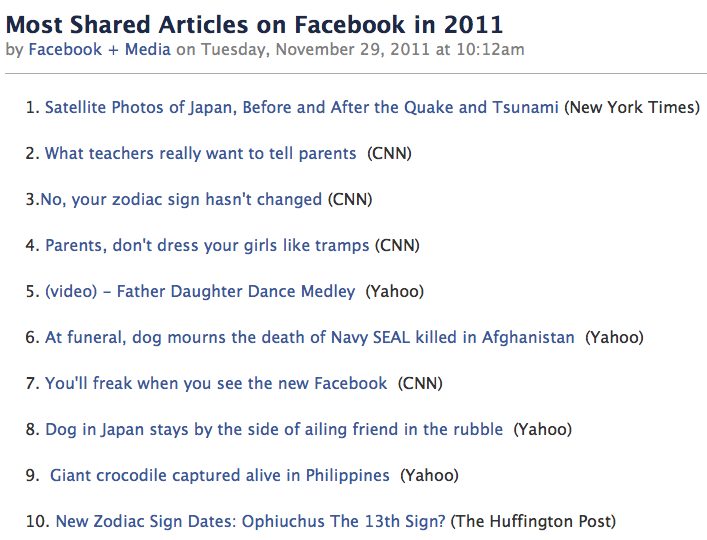Articles about natural disasters and parenting advice from CNN, Yahoo! News, the New York Times, and Huffington Post topped Facebook’s new list of the most shared articles in the US for 2011. Facebook measured which articles were Liked, Shared, or copy and pasted into the social network and found that subjects such as “Parents, don’t dress your girls like tramps” and “What teachers really want to tell parents” were the most popular, along with news about the Japan tsunami and rumored changes to zodiac sign arrangements. The list provides insight into Facebook’s user base, which skews more towards middle-aged parents than most expect. Unfortunately, it also illuminates the United States’ attraction to tragedy and aversion to real issues — only one article in the top 20 dealt with the financial crisis.
With 800 million users, studying Facebook has become the best way to take the pulse of the world. It does exclude much of the world’s truly impoverished, but these people are difficult to poll at scale with any method. Outside of a bias towards those of higher socioeconomic class, and China’s absence, Facebook represents a relatively accurate cross section of the world’s demographics, making this study of most shared articles quite telling about both what the world is interested in, and what journalistic forms are most viral.
Parenting was likely such a popular topic because the articles are relevant to both youngsters and middle-aged parents, two of Facebook’s biggest demographics. Surprisingly absent were articles aimed squarely at college students, indicating that Facebook has significantly diversified its user base from where it first started. Just one on how to attain a dream job cracked the list.
Many of the top articles featured videos, including Parents, don’t dress your girls like tramps from CNN, and Father Daughter Dance Medley and At funeral, dog mourns the death of Navy SEAL killed in Afghanistan from Yahoo. These types of posts are lucrative for news outlets, as the can charge advertisers high sums to run pre-rolls before the videos. 3 of the top 40 posts related to Steve Jobs, yet only one other entry discussed the passing of a celebrity, so maybe we’re not completely obsessed with death. And of course, posts focusing on animals faired well, as they represent a relaxing distraction that many browse the web in search for.
This year’s list of most shared articles did not count automatic shares through Open Graph apps and websites. If included next year, we may get a more accurate look at what were in fact the most read articles, not just the most frequently shared. In a separate Developers Blog post, Facebook described the success of Open Graph news reader apps. Yahoo News’s site has increased Facebook referral traffic by 600% thanks to an Open Graph integration, and the The Independent now has 1 million monthly active users on its Open Graph Site.
Some dedicated reader apps that live on Facebook are also finding success, as the Guardian now has nearly 4 million MAU with half under age 24, and the Washington Post has 3.5 million MAU, 83% of which are under age 35. Facebook may want to tout its ability to help news outlets reach younger readers. However, it may have actually revealed that younger users are more negligent, or at least less concerned, with their privacy controls. Older users may be shying away from Open Graph apps and sites that by default share each article they read.

